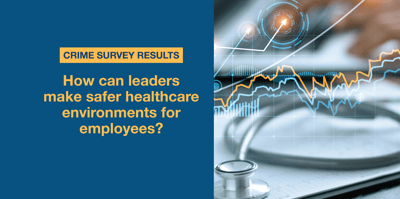Blog
Preventing Hospital Workplace Violence: A Look at New Requirements From The Joint Commission
Many organizations implement healthcare safety and security solutions in response to rising workplace violence. The Joint Commission (TJC) developed new and revised workplace violence standards to address these issues, effective January 1, 2022. The requirements apply to all Joint Commission hospitals and critical access hospitals.
In addition, TJC completed a thorough analysis of its Emergency Management (EM) chapter. New and revised EM standards for all accredited facilities are effective on July 1, 2022. Below we detail why new and revised requirements were needed and go over what the standards cover.
Moreover, we'll look at the improvements to The Joint Commission’s Emergency Management project and discuss how regulatory compliance software can help your Joint Commission hospital stay compliant.
Who is The Joint Commission (TJC)?
TJC is the oldest and largest standards-setting and accreditation organization nationally, certifying more than 22,000 healthcare organizations and programs per year. TJC provides organizations with standards for evaluating, measuring, and enhancing performance.
TJC surveyors assess standards compliance during an unannounced visit to an accredited facility a minimum of once every three years. In addition, hospitals submit data on how they treat conditions every three months, and the information is available to the public.
Why New Workplace Violence (WPV) Standards?
According to The Joint Commission, "the high incidence of workplace violence prompted the creation of new accreditation requirements." Before TJC's new and revised standards, very little information existed to support hospitals and healthcare workers. A few states have legislation in place, but the only federal regulation was the General Duty Clause of the Occupational Safety and Health Act of 1970, which doesn't provide recommendations for managing workplace violence.
Furthermore, while OSHA offers guidelines for workplace violence prevention, these are only advisories, not requirements. The new and revised requirements fill this gap, giving Joint Commission hospitals access to a framework for building vital workplace violence prevention programs.
State of Workplace Violence in Hospitals
Workplace violence in healthcare settings has increased steadily over the last decade, affecting hospital staff, patients, and visitors. The healthcare industry has a higher incidence rate of intentional injury by another person than other sectors, and this figure is more elevated for hospitals than for ambulatory healthcare services. While rates were high pre-pandemic, COVID-19 amplified the issues.
As a result, 82% of healthcare workers "reported experiencing at least one type of workplace violence during the COVID-19 pandemic," according to National Nurses United (NNU). These higher rates continued throughout 2020 and 2021, making it challenging to keep hospital employees and visitors safe.
Recent Incidence Data and Statistics
NNU's April 2022 survey found that 48% of hospital nurses "reported a small or significant increase in workplace violence," an upsurge of almost 57% from September 2021. Workplace violence reverberates across healthcare organizations, increasing costs, employee absences, and worker turnover. The American Hospital Association (AHA) estimated that "violence response efforts cost U.S. hospitals and health systems approximately $2.7 billion in 2016," a figure that continues to rise.
Workplace violence also carries over to patients, with the American College of Emergency Physicians (ACEP) reporting that roughly 80% of emergency physicians said, "violence in the emergency department harmed patient care." Yet, these figures are likely much higher as experts believe hospital violence is underreported — an issue compounded by the pandemic. A study published in Workplace Health & Safety journal found that "one in 10 nurses felt reporting the incident was more difficult during the pandemic."
The Joint Commission New and Revised Requirements
Before revising the standards, TJC completed a public field and literature review while seeking guidance from the Technical Advisory Panel (TAP) and Standards Review Panel (SRP). The new and revised requirements offer a framework for Joint Commission healthcare organizations. Hospitals should use the standards to improve workplace violence prevention systems. The requirements define how a Joint Commission hospital manages security and safety risks and monitors conditions, including the role of leadership and specifications for ongoing staff training.
Here's an overview of the new standards:
- Standard EC.02.01.01 requires a yearly worksite analysis followed by documented actions to alleviate or eliminate risks. The study should review existing policies and training to conform to current best practices, laws, and regulations.
- Standard EC.04.01.01 mandates that hospitals develop processes for monitoring, investigating, and internally reporting injuries, illnesses, and incidents. This includes safety and security incidents concerning staff, patients, or others within its facilities.
- Standard HR.01.05.03 defines the training requirements for staff, leadership, and licensed practitioners. Accredited facilities must provide a workplace violence definition and role-based education, such as nonphysical intervention training, de-escalation, and physical intervention skills.
- Standard LD.03.01.01 requires hospitals to appoint a multidisciplinary team to develop the workplace violence prevention program and a designated individual to lead it. It also defines the types of processes and policies required for accredited hospitals.
The Joint Commission's Emergency Management (EM) Project
The emergency management chapter provides standards for preparing for all-hazard emergencies that all Joint Commission hospitals must follow. TJC began reevaluating these standards in 2019 and used insights from the pandemic to restructure the existing program. As a result, TJC reduced the number of performance elements to 60 from 124, removed redundant requirements, and added new provisions.
The new and revised standards go into effect on July 1, 2022. Hospital stakeholders can start early by using pre-planning and incident command solutions to centralize data, digitalize the FEMA ICS form process, and gain greater visibility.
Improvements to the EM chapter standards and elements of performance (EPs) take a comprehensive, all-hazards approach to program development, leadership oversight, and vulnerability analysis. It requires hospitals to have communication, staffing, disaster recovery, and patient care plans. Joint Commission hospitals must also develop strategies to ensure continuity of operations and proper management of resources and assets.
Regulatory Compliance Software to Prepare and Meet TJC New Standards
Preventing workplace violence in hospitals and complying with TJC standards are essential for hospitals. End-to-end software solutions can be leveraged to meet TJC requirements, from ensuring a swift response during an emergency, increasing accountability within the organization, and streamlining communications.
Guarantee that your healthcare organization can meet the latest standards by partnering with Omnigo. Report Exec is compatible with NIBRS, and Omnigo Command and Planning, powered by Rhodium and prepares your hospital for effective emergency management. Likewise, Guard Tour helps monitor checkpoints while Omnigo's Safer Communities suite streamlines communication.
A Step in the Right Direction
The latest Joint Commission standards provide the foundation to keep your patients, employees, and visitors safe. Leverage your software tools to increase accountability and streamline reporting processes. Download the TJC compliance checklist to ensure your organization is in a better position to meet the new and revised requirements.
Omnigo Software delivers innovative solutions that enable you to better protect your community, safeguard your brand, and secure your property and assets. Learn more by checking out our comprehensive suite of healthcare security solutions.
More from the blog
View All Posts
How to Assess Your Healthcare Facility for Workplace Violence Vulnerabilities
Read More
5 Steps to Improving Healthcare Worker Well-Being [Plus Bonus Tips]
Read More
How can leaders make safer healthcare environments for employees?
Read MoreSubscribe to email updates
Stay up-to-date on what's happening at this blog and get additional content about the benefits of subscribing.
